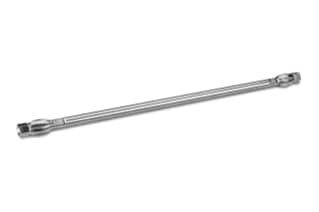
|
Chemistry |
C8 |
|
Separation Mode |
Reversed Phase |
|
Particle Substrate |
Hybrid |
|
pH Range Min |
1 pH |
|
pH Range Max |
12 pH |
|
Maximum Pressure |
6000 psi (415 Bar) |
|
Endcapped |
Yes |
|
Silanol Activity |
Low |
|
Particle Shape |
Spherical |
|
Particle Size |
5 µm |
|
Endfitting Type |
Waters |
|
Pore Size |
130 Å |
|
Format |
Column |
|
Surface Area |
185 |
|
System |
HPLC |
|
Particle Technology |
BEH |
|
USP Classification |
L7 |
|
Inner Diameter |
4.6 mm |
|
Length |
250 mm |
|
Carbon Load |
13 % |
|
UNSPSC |
41115709 |
|
Brand |
XBridge |
|
Product Type |
Columns |
|
Units per Package |
1 pk |
XBridge BEH C8 Column, 130Å, 5 µm, 4.6 mm X 250 mm, 1/pk
With an unmatched potential column lifetime, the flexibility to work across an unprecedented range of mobile phase pH and temperatures, the XBridge family of columns allows for seamless migration to UPLC technology without compromising quality. By having maximum flexibility in HPLC methods, chromatographers can develop robust separations in less time with greater confidence and fully realize the power of pH. This power is combined with innovative bonding, end-capping, and particle synthesis to make the XBridge BEH C8 Column a trusted piece of lab equipment for a range of challenging chromatographic separations.
The presence of Waters’ proprietary BEH Technology allows chromatographers the flexibility to scale between UPLC, analytical and preparative scale chromatographic platforms. This scaling is possible while facilitating reduced USP peak tailing factors for bases, increased chemical and mechanical stability, and increased high pH stability of the column.
Like the XBridge BEH C8 Method Validation Kit, 130Å, 5 µm, 4.6 mm X 250 mm, 3/pk, this column is a popular choice that is useful for a wide variety of separations and is recognized by scientists globally. In these columns, low pH stability in bonded phases is improved using a proprietary trifunctional bonding and end-capping process. XBridge particles also incorporate ethylene bridges within the silica matrix which resist particle distribution, allowing for greater chemical stability even with higher pH ranges.
Each batch of XBridge material is tested chromatographically using acidic, basic, and neutral analytes. These results are held to narrow specification ranges that ensure excellent and reproducible performance. All packing materials for XBridge BEH C8 Columns are manufactured in a cGMP, ISO 9001:2000 certified plant using ultra-pure reagents.
What Solvents Can I Use With XBridge BEH C8 Columns?
In order to ensure maximum column performance, high-quality chromatography grade solvents are recommended. Pall Gelman Laboratory Acrodisc filters are recommended and all aqueous buffers should be filtered prior to use. Be cautious of solvents that contain suspended particulate materials as they will generally clog the outside surface of the inlet distribution frit of the column. This will lead to higher operating pressure and poor performance. All solvents should be degassed thoroughly before use to prevent bubble formation in the pump or detector. It is also recommended to use an on-line degassing unit, especially when running low-pressure gradients.